Introduction
A lot of equipement that could cross any camper min but it always about “what actually do I need?”, it is about weight, how can I make it Ultralight or as lighter as possible, in this article I will show you a comparison between the ultralight and the old school heavy backpacking because today we’re talking about: lightweight baby, and if you appreciated the Ronnie Coleman reference, we’d probably be friends, so what are we talking about today we’re talking about ultralight hiking!
Whoa hold on there, so I just made what many would consider to be a mistake which has turned into a fun little teachable moment.
Table of Contents
ToggleSee before I made this Article, I was operating under the misconception that ultra-light hiking meant taking your weight and bringing it down as low as humanly possible, and to an extent it kind of does but there is a more accepted definition among the ultralight community, that your goal is to get your base weight under 10 pounds, so your base weight is everything but consumables, like: fuel, water, food and then your ultralight backpacking if you get your base weight under 20 LBS then your lightweight backpacking
spoiler alert
Although it’s a bit of a spoiler, I managed to reduce my base weight to 10.3 lbs. I never measured it in my previous reviews, but out of curiosity, I checked and found I was at that weight. I suppose it’s getting pretty close to ultra-light backpacking! Anyway, let’s get back to the article.
Things to Consider: Ultralight vs. Heavy-Duty Backpacking
When planning your camping adventures with the best camping tents for 2025, you’ll need to decide between ultralight or heavy-duty backpacking approaches. This choice affects everything you carry!
Ultralight Backpacking: The Minimalist Approach
Ultralight backpackers try to keep their total pack weight under 10 pounds (not counting food and water). Every item must earn its place in your pack!
Ultralight Backpacking Essentials:
Shelter: Tents under 2-3 pounds, tarp shelters, or even bivy sacks
- Sleep System: 20-32 oz sleeping bags and inflatable pads under 16 oz
- Cooking: Single-pot alcohol stoves or small canister stoves
- Water: Smart bottles instead of heavy reservoirs, lightweight filters
- Clothes: Just one extra set, quick-dry materials, no cotton
Real-World Example: Last summer, I hiked 22 miles in one day on the Pacific Crest Trail with my entire kit weighing 12 pounds. I used a tiny stove, a 2-pound tent, and wore the same shirt for three days. I was stinky but happy with how easy the hiking felt!
Pros of Ultralight Backpacking:
✅ Less fatigue and joint pain
✅ Ability to cover more miles each day
✅ Easier stream crossings and scrambling
✅ Less fuel needed (carrying less weight means your body works less)
✅ More enjoyment of the journey
Cons of Ultralight Backpacking:
❌ Often more expensive gear
❌ Fewer comfort items
❌ Less margin for error in bad conditions
❌ More planning required
❌ Gear might wear out faster
"When I switched to ultralight backpacking, I stopped dreading hills. The mountains became playgrounds instead of punishment." - My experience after shedding 12 pounds from my pack weight
John Doe Tweet
Heavy-Duty Backpacking: Comfort and Durability
Heavy-duty backpackers typically carry 30-45 pounds. The extra weight comes with extra comforts and reliability.
Heavy-Duty Backpacking Essentials:
- Shelter: Sturdier tents (4-7 pounds) with extra features and space
- Sleep System: Thicker sleeping pads, more comfortable (and heavier) bags
- Cooking: Multi-pot cooking systems, camp stoves with better simmer control
- Water: Larger capacity, water reservoirs with drinking tubes
- Clothes: Extra options, more layers, sturdier materials
Real-World Example: During a week-long trip in Yellowstone, my friend carried a 42-pound pack that included a camp chair, a thick sleeping pad, a French press for coffee, and extra clothes for any weather. He hiked slower than me but was definitely more comfortable at camp every evening!
Pros of Heavy-Duty Backpacking:
✅ More comfort at camp
✅ Better preparedness for changing conditions
✅ More durable gear that lasts longer
✅ Often less expensive gear options
✅ Fewer compromises on what to bring
Cons of Heavy-Duty Backpacking:
❌ More fatigue and possible pain while hiking
❌ Slower pace and fewer miles covered
❌ Harder on your body over long distances
❌ Requires more fitness to carry comfortably
❌ Tougher scrambling on difficult terrain
| Item | Ultralight Approach | Heavy-Duty Approach |
|---|---|---|
| Backpack | 1-2 lbs, 40-55 liters | 4-7 lbs, 60-85 liters |
| Sleeping Bag | 1-2 lbs down bags | 2-4 lbs synthetic bags |
| Sleeping Pad | ½ lb inflatable or foam | 1-2 lb self-inflating |
| Kitchen | 3-8 oz stove, one pot | 1-2 lb stove, multiple pots |
| Water System | Smart bottles, light filter | Reservoir, pump filter |
| Clothing | Single extra layer, minimal | Multiple options, more backup |
| Extras | Almost none | Camp shoes, chair, pillow |
How to Choose Your Approach
Ask yourself these questions to decide between ultralight and heavy-duty backpacking:
- What’s my fitness level and joint health
- How important is comfort at camp vs. comfort while hiking?
- What’s my budget for gear?
- Will I be hiking in remote areas far from help?
- What kinds of weather might I encounter?
Expert Advice: For most weekend warriors just starting out, aim for a moderate approach of around 20-25 pounds. You can always lighten your load as you gain experience and identify what you really need versus what you just think you need.
Statistics Speak: A survey of 1,000 long-distance hikers showed that 78% started with heavier packs (35+ pounds) but gradually lightened their load as they became more experienced. By the end of their journeys, their packs averaged 18-22 pounds.
Finding Your Sweet Spot
- Many experienced backpackers find a middle ground between these extremes:
- Taking a lightweight tent but bringing a slightly heavier sleeping pad for better sleep
- Choosing one “luxury item” (like a small pillow or camp chair) while keeping everything else light
- Using lightweight gear for fair weather trips but bringing heavier, more protective equipment for shoulder seasons
When shopping for the best camping tents for 2025 and other gear, remember there’s no perfect answer for everyone. Your ideal setup should match YOUR adventures, body, and preferences!
What should you take
So, this is kind of interesting for me because I’ve always been firmly on the side of carrying more stuff super Light Equipment it costs a lot of money, now that I’m in this position I’m getting a lot of super lightweight gear and I thought “hey I should do an article about this”, so what I’m going to do is I’m going to pack our standard backpack:
The backpacks:
Here with which is a Kelty outskirt 70 I (180$):
(I’ve attached the 50l version on amazon as the 70l is no longer available at the moment of writing this article)
love this thing I’ve had it for a very long time.
On the lightweight side, we have the Mystery Ranch Ratx 47. This pack is lighter and has a smaller carrying capacity. I removed the frame and trimmed off a few extra ounces, bringing it to just under 3 lbs. In comparison, this larger backpack weighs around 3.7 to nearly 4 lbs.
The basic gears
There are some pieces of equipment I couldn’t duplicate for each side of this experiment. We’ve got my camp stove, fuel, food, bear can, and my small pillow—none of which I have duplicates of. So, I’ll set these aside, weigh them, and add that total weight to whichever side we finish with. Now, let’s start packing, shall we?
Time to pack
On the heavier side here we’re going to start with a sleeping bag, this is a Kelty sleeping bag I don’t know what it is but it’s pretty chunky.
On the ultra-light side we’ve got the Big Agnes Greystone 30 (230$) it’s really really compressable very small I’m sure you could put it in a smaller bag and get this thing even tighter than it already is.

then we’re going to pack our standard tent over here we’ve got a Big Agnes copper spur HV ul2. so this is you know what this is a pretty lightweight TENT I’m going to go get another one okay much better option here.

Wait, I might have a better idea,
okay so, I changed my mind and now I’m bringing this Kelty Tanglewood Tent. (110$)
and on team ultra-light we’ve got the Big Agnes gold Camp ul3 tarp. (150$)
As you can see until now, you pay extra money just to win extra pounds on your back.
We’re also including a footprint for the tent (30$). While some people aren’t fans of them due to the extra weight, I personally find them useful, so we’ll be bringing it along.

up next on team heavyweight we’ve got the Helix insulated air pad from REI (170$)

We can alreay feel the difference between the two backpacks.
We have the Zenbivy ultra-light sleeping pad here (200$). You’ll notice I’m not packing any clothes since we’re assuming their weight will be roughly the same on both sides. However, we will include a jacket—this is an older Columbia piece I’ve had for about 10 years, which speaks to the quality of their products. Let’s estimate its value at $30.
we’ve got the arc’TeryX proton hybrid lightweight hoodie (300$)
We’ve got shoes which I think is an important consideration, these are our Keen heavy duty Targhee 4 shoes (160$).

On this side, we have lightweight Brooks Ghost running shoes ($140). Many people swear by running shoes, and I believe that those who wear trail runners will find them comparable in weight to street running shoes.

Water camping gear
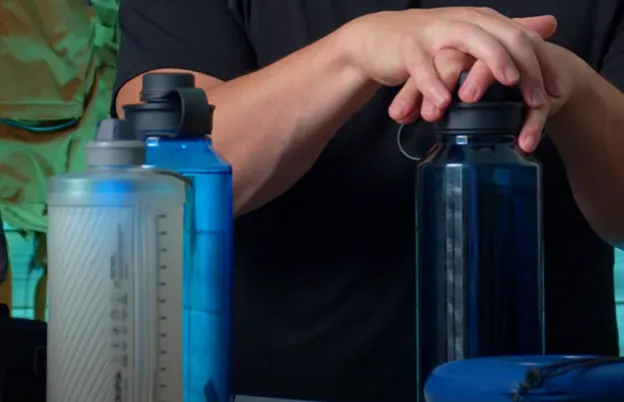
Now, let’s discuss water. I’ve noticed that people often bring enough water for their initial hike and then use a filter bottle, like the Hydrapak water filter cap ($55). This allows you to take water directly from a source and drink it safely.
there’s a built-in filter on top, and then this thing will -it weigh nothing- compresses down and can kind of fit anywhere in your pack whenever you don’t have water in it.
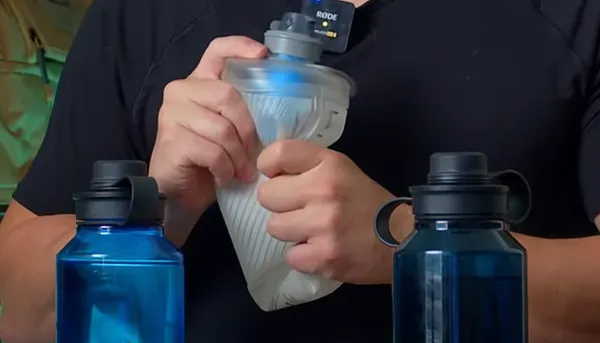
I want to emphasize that I don’t like taking chances with water sources. You can never be certain if a water source will be reliable, which can be particularly problematic if you’re relying on it for an extended period during your hike. That’s why I always bring much more water than I think I’ll need. Remember, if you’re hungry you’re hungry but if you’re thirsty you’re dying. We definitely want to avoid that.
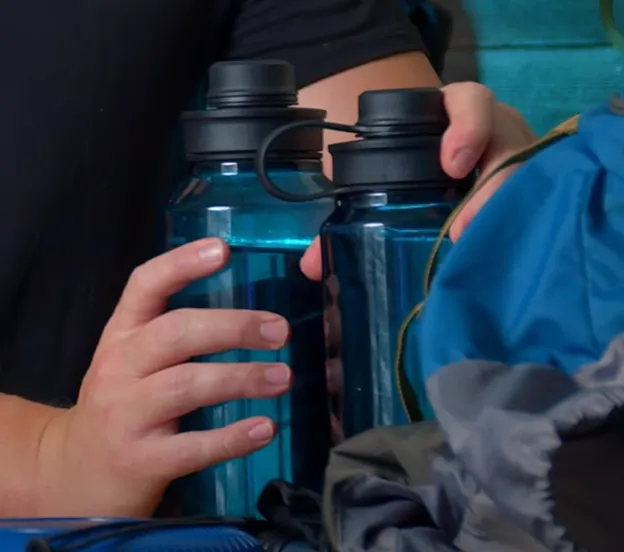
These are YETI 50/34oz Yonder Water Bottle (25$), imagine that 85 ounces of water over the heavy side but over here we’ve got a 50 ouncer as well as another 50 oz filter bottle by hydropack water filter cap.
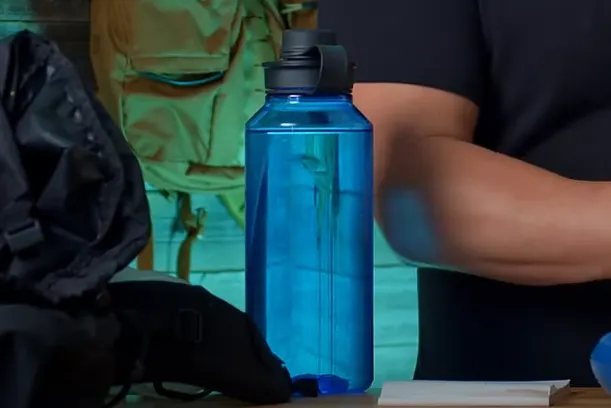
Other tools to pack
We also have a few essentials that I usually bring on a camping trip. I’ve got my multitool, a mess kit, and a handy folding stool from Hill Sound, the same company that makes crampons.
Something else I just considered we are going to need a filtration system which will be a Hydrapack Seeker 3L (60$) over here on the heavier side because we don’t have a filter bottle okay let’s hit the scales.
Moment of truth
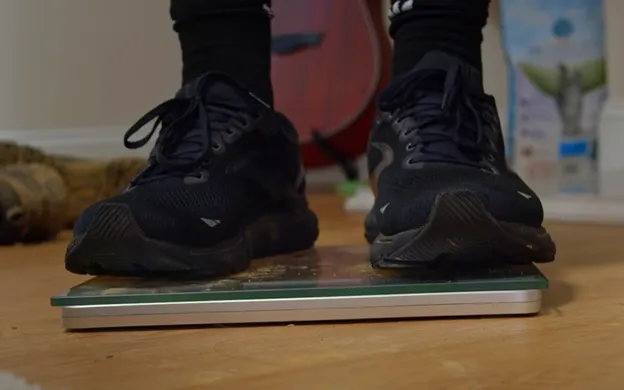
okay so let’s get my starting weight, 212.9 lbs. And now we’ll get the weight of the Universal Supplies here and they are about 3.5 lbs to the totals of each backpack to account for that let’s do the heavy one first now for the Moment of Truth. 239.6 lbs, this brings all of this to 243.1 lb minus my weight at 212.9 gives us 30.2 lb that’s actually not that heavy now. All of that is for 837$ Total.
Let’s move on to our lighter weight system, and I can already feel a significant difference. We’re currently at 228.6 lbs, which plus 3.5 lbs for supplies brings us to 232.1 lbs. After subtracting my base weight, that equals 19.2 lbs with a total cost of $1,429. That’s a substantial difference! The entire third of the weight we’re discussing includes the same gear, minus a few minor features like the camp stool and knife. Both backpacks contain the same equipment, yet there’s a noticeable weight difference. The gear in the ultralight backpack isn’t the absolute lightest available, and while you can go even lighter, it will come at a higher cost.
Conclusion
We’re nearing the end of the article, so where does that leave us? To conclude, I realize that I would definitely choose the ultralight backpack. If I had to head into the woods right now, I’d opt for the lightweight setup since I can feel the heavy backpack weighing me down and making me sweat. While the ultralight pack is more expensive and contains lighter, more compact gear, that doesn’t mean you have to invest in it. You can still enjoy hiking with heavier, older equipment; there’s value in that experience. Carrying a significant load up a big mountain offers its own unique reward. If that’s what you prefer, there’s no need to switch to ultralight gear.
Recommendation
What do I do? what’s my recommendation?
here well I like to do The Best of Both Worlds kind of a copout answer I like to use super light stuff wherever I can to make room for the other little gizmos and gadgets and goodies that I like to bring out in the woods that make my quality of life that much better so I will use a lightweight backpack I’ll use a lightweight tent I’ll use a lightweight sleeping bag so that I have more room for other stuff namely camera equipment but you might bring whatever it’s about moderation people moderation and spending what you can when you can if you want to so get out there enjoy the woods.
